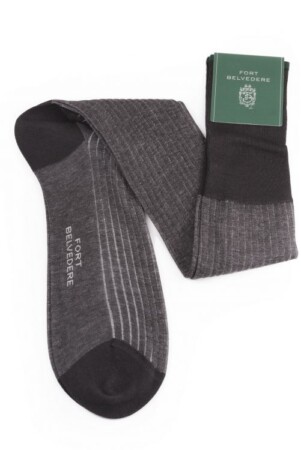When it comes to garment care, a garment steamer can be an excellent investment for those interested in taking their wardrobe maintenance to the next level. But, how can you determine what makes a garment steamer high quality? We test $500+ worth of garment steamers to help you determine which one might be best for your needs.
We’ll explain the primary qualities you’ll want to see in a garment steamer, and then, using these criteria, we’ll put five different models to the test. Do note that today’s post isn’t about the pros and cons of steaming your clothes versus ironing them. However, if you’d like to learn more about that exact subject, you can consult our previous post.
Iron vs. Steamer: Which is Best for Your Menswear Wardrobe?
Unlike an iron, which uses both steam and pressure to remove wrinkles, steamers usually rely solely on steam propelled from a wand or vent to relax the wrinkles out of clothing.
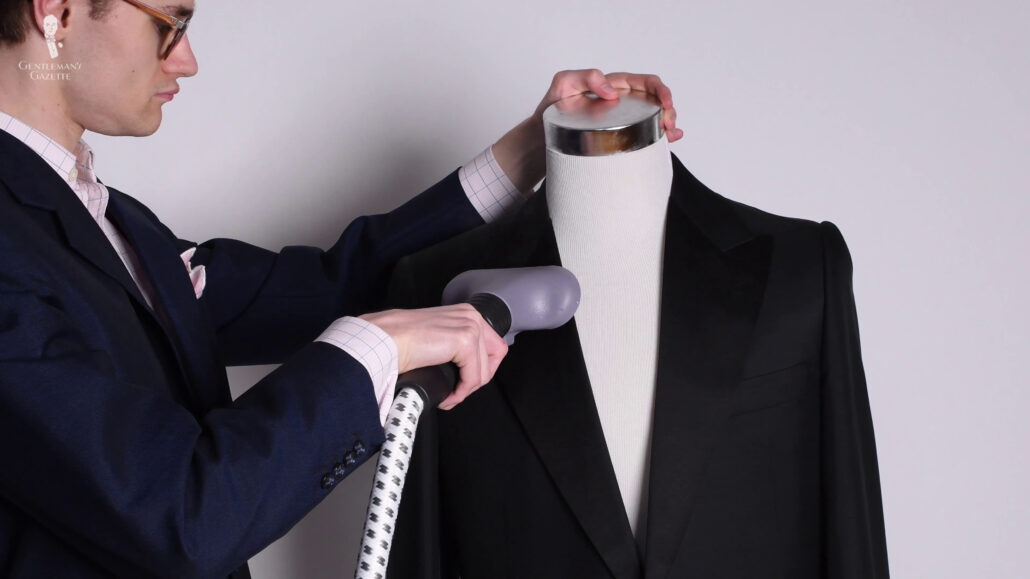
Today, there are two primary types of domestic garment steamers. The first of these is a full-size garment steamer that consists of a body with a water tank and nozzle or wand, and the second is a mini or travel garment steamer featuring a water reservoir and nozzle all in one compact, handheld device.
Which steamer type is right for you, then? Well, the first thing you’ll need to decide upon is what size is best. If you’re primarily interested in a steamer that will allow you to touch up various garments on occasion or that you’ll be able to bring with you when you travel, then a mini steamer is going to be the right choice.
Conversely, if you want to steam several garments fairly regularly or do a semi-regular deep steam of all of your garments, then you’re probably going to want to go with a full-size model. And, of course, you may also benefit from having one of each type, especially if you’d like a mini model for travel and a full-size model for home use. Naturally, both types are going to be represented among the models we’ll be testing today.


Speaking of which, let’s get into how we developed the list of steamers we’ll be testing. The five steamers we’ll be reviewing today were selected to satisfy our requirements when it comes to features, functionality, size, and price points. Then, we cross-referenced our criteria with trustworthy online review sites, sprinkled in our own personal experiences with other garment steamers, and developed a list that would allow us to test the widest range of steamers possible.
The Steamers We’ll Be Testing: Travel Steamers
Our first three garment steamers today are all mini or travel models.
1. 700W 240mL HiLife Steamer

First up is the HiLife steamer, which retails for about $27. It has 700 watts of power and a reservoir capacity of 240 milliliters. This is a steamer that is stripped down to the very basics of what you need, but it is currently the number one seller on Amazon at the time of writing this post.
2. 1600W 250mL Atefa Steamer
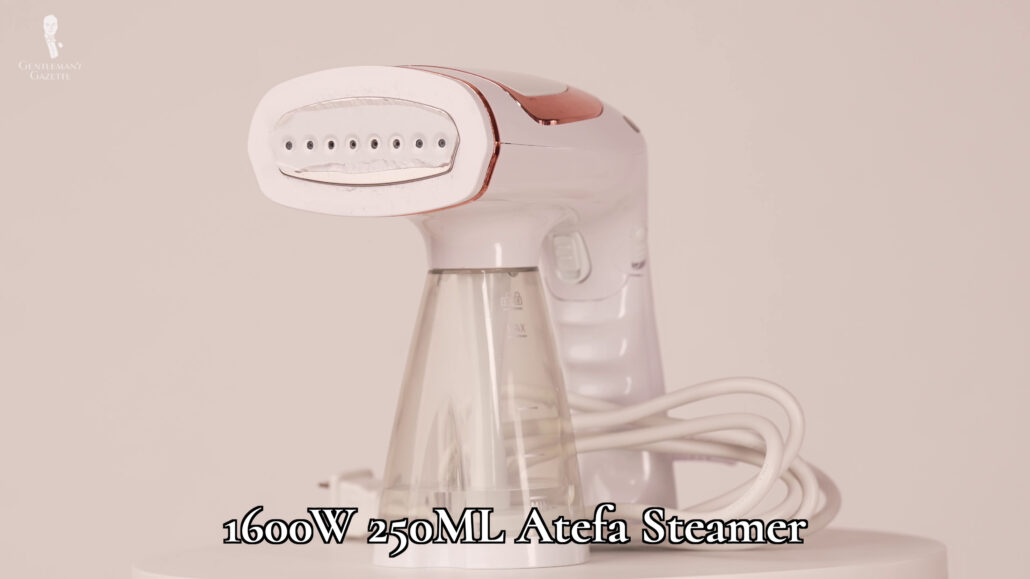
Next, is the high-powered Atefa steamer which retails for about $48 and comes fully loaded with accessories and features. It has 1600 watts of power and a reservoir capacity of 250 milliliters.
One additional note here: we believe that we may have received a model that had previously been used and returned, as there were signs of wear on the steamer from the time that we unboxed it.
3. 1870W 215mL ConAir Turbo Extreme
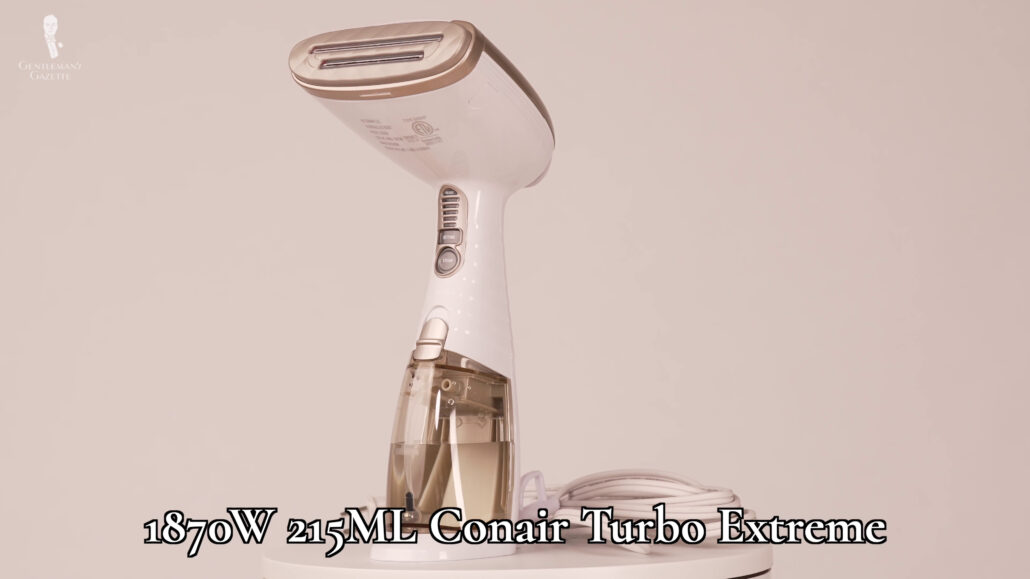
Finally, for the handheld models, we’ll be looking at the ConAir Turbo Extreme, which, unfortunately, isn’t a long-awaited sequel to the 1997 cinematic masterpiece “Con Air.” What it is is another high-powered, highly-accessorized steamer from one of the best-known names in garment care today.
It retails for about $60, has 1870 watts of power, and has a reservoir capacity of 215 milliliters.
Full-Sized Steamers
Next, while we’re only looking at two full-sized models today, we’ve chosen two from opposite ends of the cost spectrum so we can see if price really has a bearing on the quality of floor models.
4. 1500W 2L Pure Enrichment PureSteam Pro

First is the more moderately-priced Pure Enrichment PureSteam Pro. It retails at right around a hundred dollars, and it has a telescoping garment rack and push pedal functionality. It’s got 1500 watts of power and a tank capacity of 2 liters.
5. 1300W 2.84L J-2000M Jiffy Steamer

And at the higher price point, we’ve got the J-2000M from Jiffy. This one comes in at around $260 and features a metal steamer head and all-brass couplings. It has 1300 watts of power and a tank capacity of 2.84 liters.
And as mentioned, it comes from Jiffy, a leading name in garment steaming since 1940, as you can probably tell from its mid-century, modern design. Well, if it ain’t broke, don’t fix it.
One more note before we move on: Today’s post is 100% not sponsored. All of the products featured were purchased with our own money, and all of the observations and opinions here are completely our own.
10 Features Most Important in Steamers
Let’s go through the ten features we think are most important when selecting a garment steamer and see how our five steamers stack up.
1. Steam Quality

First on the list, perhaps unsurprisingly, is steam quality. Dense consistent steam is required to release wrinkles quickly and efficiently, so that’s exactly what we want to see.
For full-sized models, you’ll also want to be aware of hose functionality, as hoses that twist or kink can cut off your steam supply. For test purposes, we’re going to see how well each of our models steams a cotton dress shirt, linen trousers, and a wool suit.
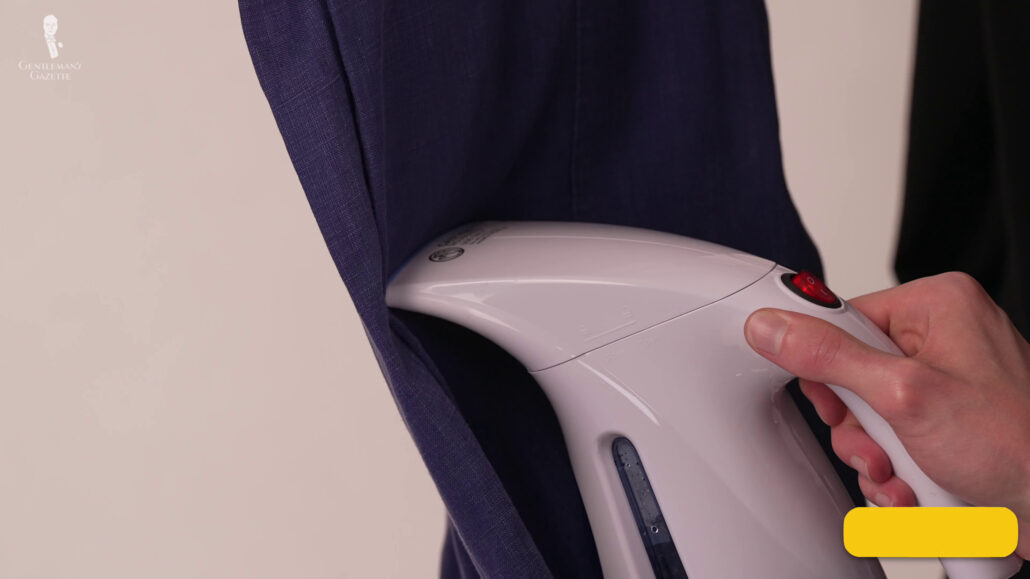

We’ll start off with the HiLife steamer, which definitely did help to lessen the appearance of some wrinkles, but didn’t really go all the way to removing many of them. Both the cotton shirt and the linen trousers, in particular, did hang on to stubborn creases.
The Atefa steamer had a particularly poor showing. The garments did all hang on to most of their wrinkles, and the steamer itself belched a fair amount of water onto the clothes.
As for the ConAir steamer, in short, we were impressed that this one managed to remove most wrinkles fairly quickly due to the generous amount of steam output and the variable temperature settings. One thing to note here though is that the steam was vigorous enough to spread out toward my other hand and give my left thumb a slight scalding, but this is mostly operator error.


The overall performance of the PureSteam steamer wasn’t bad. The wrinkles in the linen trousers, in particular, seemed fairly resilient and probably would have required more time or further passes. This one was better than the HiLife and the Atefa, but not as good as the ConAir.
And as for the Jiffy steamer, while I did have to spend more time on each garment than I did with the ConAir, for example, the end results were still good in that most, if not all, of the wrinkles were removed effectively. The steam did spread out enough to catch my opposite hand again, and my thumb was definitely scalded, though this could be chalked up mostly to operator error, and holding the wand at the proper angle could mitigate this, but more on this point later.
2. Steam Efficiency

When you’re ready to steam your clothes, few things are more frustrating than having to wait around for your garment steamer to heat up so that you can get started. It’s as frustrating as waiting for a watched pot to boil. Not surprisingly, the rapidity of steam production is a major selling point for all of these models, so we’ll compare actual heat-up times to the advertised times.
The HiLife has an advertised heating time of 130 seconds or 2 minutes and 10 seconds. We found its real heating time to be 105 seconds or 1 minute 45 seconds. This was faster than advertised, but still longer than all of the other models we tested.
The Atefa had an advertised heating time of 20 seconds, but we found that it took 50 seconds to get up to temperature. This was the only one in our testing to come out slower than advertised.

The ConAir had an advertised heating time of 40 seconds and an observed heating time of 40 seconds. Right on the money.
The PureSteam had an advertised time of 45 seconds and had an observed heating time of 30 seconds. This was the speed record holder for us.
And finally, the Jiffy had an advertised heating time of 120 seconds or two minutes. Its observed heating time was about 100 seconds or around a minute and 40 seconds. This, again, was faster than advertised but still a bit slower than most of the other models we tested.
3. Tank Capacity & Steam Duration

The next consideration is the tank capacity and steam duration. Once the steam gets going, it’s also annoying if it comes out in stops and starts because of insufficient heating or if you quickly empty the tank and have to start again. So, let’s compare water reservoir sizes and actual versus advertised total times for steam production. I have the feeling it’s going to look like a Turkish bath house here pretty quickly.
With HiLife’s tank capacity of 240 milliliters, it advertises a steaming time of 14 to 16 minutes. As we tested it, we found that roughly two-thirds of the tank was used up in about three and a half minutes of steaming. Doing some quick math, this comes out to a total tank usage time of just over five minutes. Even if we were to round generously here, we’d say it’s unlikely that you’re going to get any more than 10 minutes of steaming time total from one tank at a maximum.

With its tank capacity of 250 milliliters, the Atefa steamer advertises up to 30 minutes of total steaming time. And while we didn’t use up much of the water in the reservoir during our four minutes of steaming time, we also found it difficult to fill up the reservoir in the first place. We’ll cover this more in our next section, but overall, we’d say that 30 minutes would be an optimistic estimate for the total amount of steaming time you’d get out of one tank and that you’re probably looking at about 10 to 15 minutes of steaming time in total.
With its tank capacity of 215 milliliters, the ConAir advertises up to 15 minutes of steaming time. The ConAir steamer definitely puts out steam at a heavy rate of flow. While this is a good thing for steaming each of your individual garments, it does also mean that you’ll probably be refilling more often than with some other steamers.

The tank emptied itself roughly by half in about four minutes, so it’s a safe bet that you’re going to get around 10 minutes of steaming time. This isn’t too far off from what’s advertised and is also similar to the HiLife but with a much better steam output.
The PureSteam has an advertised tank capacity of 2 liters and advertises up to 60 minutes of steaming time.
Meanwhile, the Jiffy has a tank capacity of 2.84 liters and advertises an hour and a half of steaming time.


For each of these standing models, we didn’t actually take the time to let an entire full tank run dry. That’s frankly more steam than we’d want hanging around in our studio at one time. Extrapolating from the handheld steamers, you probably shouldn’t expect exactly what’s advertised from either of these models. But, given how much capacity each of their tanks has, you should still have plenty of time to do a mass steaming of several garments.
4. Water Control

Straightforward and easy
The water control process should be straightforward and easy to perform and not leave standing water in the reservoir, or for that matter, to leave puddles of water all over the floor or all over you.
Having dealt so much with steam, let’s now turn to the water for number four on our list: water control. Obviously, you want to be dealing with the water mostly in its steam form as opposed to its messier, more liquid form, so let’s examine the process of filling up the water tank and emptying it because, after all, you might not use a full tank of water every time you use your steamer.
You generally want this process to be straightforward, easy to perform, and not leave standing water in the reservoir, or for that matter, to leave puddles of water all over the floor or all over you. We are steaming our clothes here, not washing them.

The HiLife steamer was perfectly easy to fill up. I probably could have just poured directly from my water jug into the reservoir, but the included filling cup with its small pour spout was also easy to use.
As we alluded to earlier, the Atefa steamer has a baffling and overall poor design for filling because the reservoir must be flipped upside down in order to be filled. Due to its conical shape, it’s hard to estimate when you’ve actually reached the max fill line, and, even when you’re using the provided filling cup up, water still has a tendency to get backed up and not flow properly into the reservoir when filling. As such, we found it basically impossible to fill this one to the max fill line on the reservoir.

This steamer does come with an attachment to use a separate water bottle, which might be a good idea if you can find a water bottle that is actually compatible with the attachment. More on this in the accessories section.
We didn’t have a bad experience filling the ConAir steamer, though it is a bit finicky to make sure that you’re actually pouring the water directly into the small filling hole and not spilling anything. This would probably be easier to do if a filling cup were included or if I were just pouring from a smaller jug of water. Overall, the word I would use to describe the experience would be “fine.”
The PureSteam was generally easy to pour directly from a jug into the tank. You might get a bit overzealous and spill a little, as I did, but, again, this was a fine experience overall.
The Jiffy tank was perfectly easy to pour into, and I didn’t have any issues with spilling. A good experience.

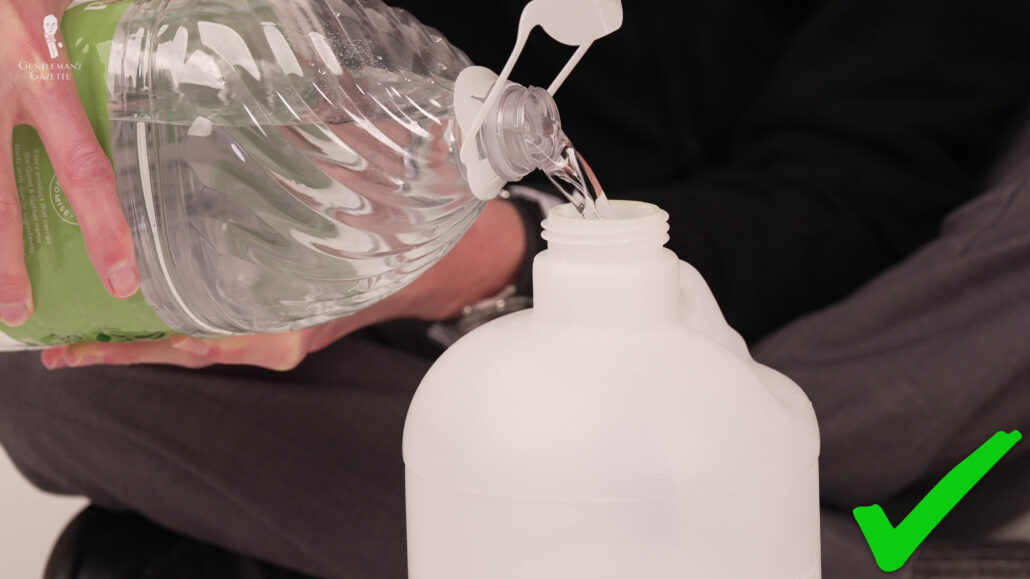
In a similar vein, we’ll also take this opportunity to point out any times when our steamers splattered or belched water out onto our garments. This usually happens because the steamer can’t keep water at a consistent temperature and is forcing liquid water out along with the steam. We are steaming our clothes here, not washing them. Did anyone else just get deja vu?
Large amounts of liquid water can damage many fabrics like cashmere, velvet, or corduroy, especially when the water is boiling hot. Not to mention it won’t be a very pleasant experience for you to be scalded.
With the HiLife steamer, there wasn’t any direct belching of water, but there was some condensation on the plastic head of the device, which would then transfer to the garments when the head made direct contact; not a deal breaker, but not great.
The Atefa steamer did put out a fair amount of liquid water directly onto our garments – the wool trousers, in particular. This was not a good showing.

In short, we didn’t experience any significant water belching issues with the ConAir steamer, so this was a good experience.
The plastic head of the PureSteam wand also experienced some condensation, but not as much as the HiLife. There was also a slight amount of belching as water condensed through the tube, but nothing that would be a deal breaker.
When it came to the Jiffy, though, we were also impressed. We didn’t experience any condensation or belching of water in the 5 to 10 minutes for which we tested this steamer.

Distilled Water
Minerals from tap water – hard tap water in particular – can form deposits inside the steamers and will make liquid water coming out more common, even on high-end models.
We also want to acknowledge here that minerals from tap water – in particular, hard tap water – can form deposits inside garment steamers that will make liquid water coming out more common, even on high-end models. Therefore, it’s generally recommended that whenever you’re using a garment steamer, you fill it with distilled water.
5. Portability, Mobility, and Stability
Portability, mobility, and stability are considerations related to different aspects of the steamers, depending on whether you’re using a full-size or travel model.
For travel models, it’s important that the steamer have a manageable weight for ease of use and comfort and a manageable size for ease of transport, especially if you intend to take it on trips. At the same time, of course, it should still be large enough to take care of business and do what it needs to do.

The design of the HiLife is small, lightweight, and compact. While you might want to pay a bit of additional attention to the handle. This one shouldn’t be any trouble to pack into a suitcase for travel. Related to the point of stability, though, I did notice that, when I accidentally tipped it over, it began to leak water onto the floor almost immediately. Not good.
The Atefa steamer has a somewhat odd shape, and, while the handle can collapse and fold inward, this doesn’t mean that the steamer is necessarily taking up less space, just the same amount of space in a slightly less awkward footprint. It’s not too heavy, though. This one did pass the tip test.

The ConAir is certainly the largest of the three portable Steamers, and its vaguely hourglass-like shape might mean that the neck could be a weak point if it’s put into a suitcase. This one might not be quite as portable or lightweight as the other two handheld steamers, but still manageable overall. And it passed the tip test. Not bad.
For full-size models, portability is less important. After all, I don’t imagine that you’re going to be bringing many full-size garment steamers on a plane as your one carry-on item. But, weight and mobility are still important factors as you want to be able to easily move your steamer around in a smooth motion. And if your steamer has a built-in garment rack or hook for your clothing, the entire assembly needs to be heavy enough that placing clothes on it won’t cause it to fall over. You certainly don’t want to be in the middle of steaming your clothes only to have them topple onto the floor and necessitate a trip to the dry cleaners.

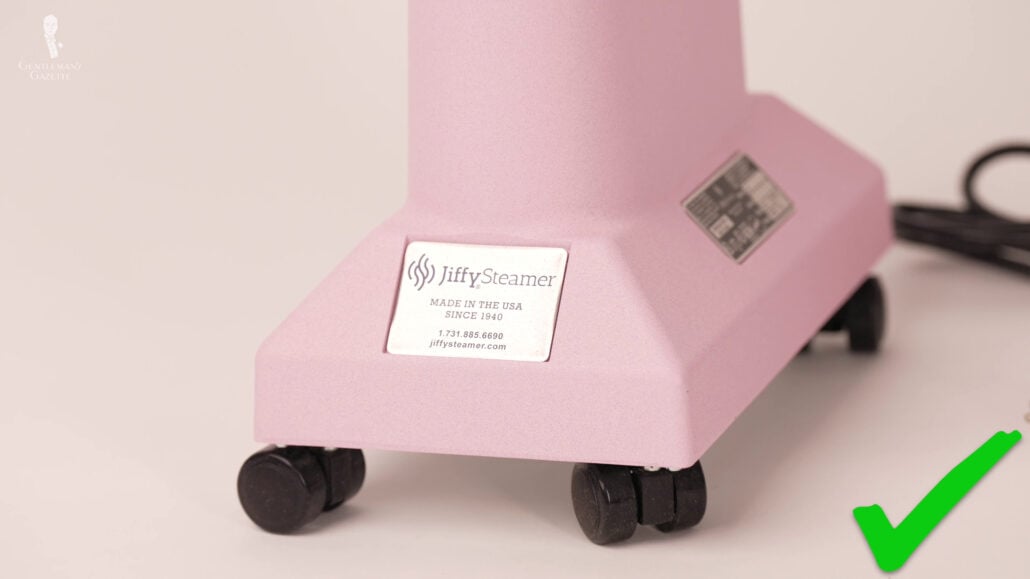
While the PureSteam model does have two wheels, it still needs to be tipped to one side to be moved around, and this experience is somewhat clunky. And with the hanger accessory attached or, if you choose to use your own hanger, the weight distribution gets more uneven and more clunky, as a result. Plus, the steamer can only be tipped in one direction to use the wheels effectively.
Perhaps unsurprisingly, the Jiffy steamer was easy to move around and felt very steady. Its four wheels can swivel to point in any direction, and the base feels well-weighted; a good showing, overall.
6. Temperature Control
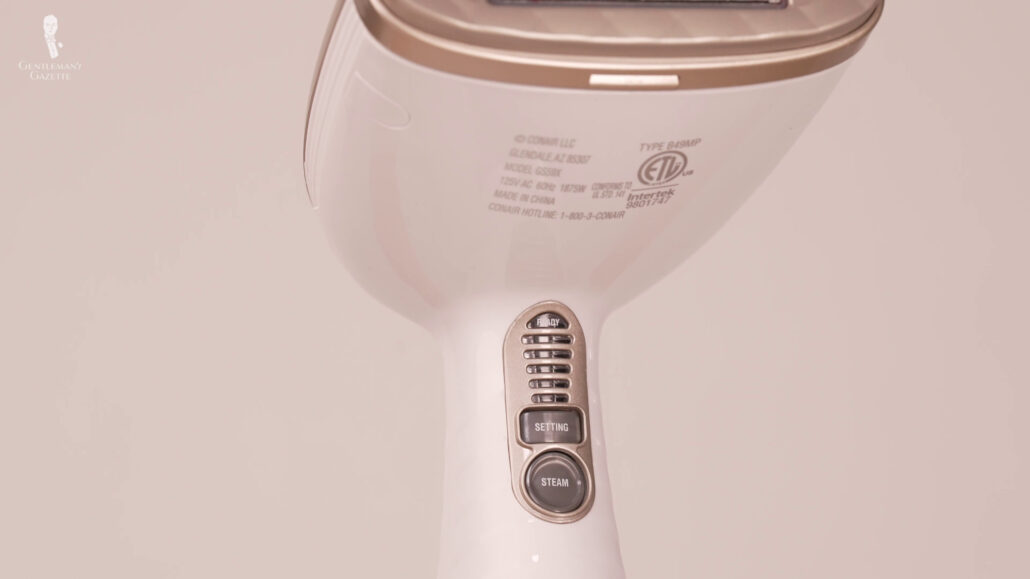
Many steamers operate by heating water to the minimum temperature required to create steam, but some do come with variable steam settings. This will allow you to set a preferred temperature so you can fine-tune your steam for different clothing materials.
In turn, this means that you can use a higher steam temperature on hardier fabrics like cotton to get wrinkles out more quickly and use a lower steam temperature on delicate fabrics like silk to prevent damage.

The HiLife doesn’t have multiple temperature settings, and it’s rated for nearly all fabric types, so it’s likely that the steam temperature is relatively low, probably around 120 to 150 degrees Fahrenheit, which is about 49 to 66 degrees Celsius. This lower overall heat might affect steaming efficiency, and we found that it did to some degree.
Also, a note that this was the only handheld model not to have any sort of trigger to release the steam. Once the unit heats up to temperature, the steam simply flows out until the tank is empty.
The Atefa steamer supposedly has three steaming modes and three steaming levels. The modes are supposed to control steam distribution, depending on whether you’re hanging a garment, flat ironing, or clamp ironing; and the levels are supposed to control heat, whether gentle, moderate, or high. Or at least, this is all true in theory. Personally, we found the settings to be very confusing to change at first, and even when we got the hang of it, we didn’t really find that trying to change them made any difference in how the unit was performing.

The ConAir has five levels of steam temperature from gentle at level one, unnamed levels two through four, and level five of “Supercharged Turbo.” The manual doesn’t explicitly suggest different levels for different fabrics, so use what you might know from setting an iron. Delicate fabrics like silk and synthetics should use a low heat setting, wool should be moderate, and cotton and linen can be higher. Still, we did find the settings on the ConAir to be easy to understand and use, and the results to be good.
The PureSteam has four thermostat-controlled heat settings – with level one being the humidity function, two being ironing for short sleeves, three for shirts, and four for suits, with the max setting at 208 degrees Fahrenheit or about 98 degrees Celsius.

Frankly, though, these four settings aren’t clearly demarcated on the simple plus-minus dial of the unit, so they seem somewhat arbitrary. Even the hottest setting didn’t seem to damage the more delicate wool trousers or their satin galon stripe, so you’re probably fine to just leave things turned up most of the time.
Somewhat surprisingly for its price point, the Jiffy steamer also doesn’t have any temperature control settings. As mentioned before, the steam was hot enough to scald me when my hand was directly next to the wand, but it was perfectly safe at any further distance. It also didn’t harm any of our testing garments, so it was a positive experience.
7. Ergonomics


Considering that you could be steaming your garments for anywhere from 15 minutes to over an hour, it will certainly be a good thing if the steamer nozzle is lightweight, easy to hold, and maneuverable enough that you won’t have to worry about accidentally scalding yourself. After all, you don’t want your steaming sessions to turn into an impromptu cooking course.
The HiLife steamer was perfectly comfortable to hold, and it was small and light enough that I wouldn’t anticipate any arm fatigue during a reasonable-length steaming session.

While it wasn’t outright uncomfortable to hold, the awkward shape of the Atefa steamer means that it has an uneven weight distribution that might lead to discomfort the longer a steaming session goes on. Also, I found that, over time, my hand did start to rub up against the power cable a bit.
As mentioned before, the ConAir is certainly the heaviest of the portable steamers, so it might lead to a bit more arm fatigue over time. It was perfectly comfortable to hold, however. The wand of the pure steam was easy and comfortable to hold. The sturdiness of the hose, however, means that it can be somewhat inflexible, so you’re not always holding the wand exactly where you’d like to. This lack of maneuverability also means that the head of the wand doesn’t like to sit properly in its holder all the time either.


And the wand of the Jiffy steamer was also perfectly easy to hold. Though, an improper angle may have contributed to the scalding that I mentioned earlier. The hose on this model is also more flexible than that of the PureSteam, so it doesn’t get in the way as much.
8. Accessories
While they are fairly simple devices at heart, many steamers will also come with accessories that are meant to improve the efficiency, ease, or results of steaming, so let’s see how useful these accessories really are or how much their absence is felt when they’re not available.


The HiLife steamer comes with two absolutely identical brush attachments, so we’re not sure why they didn’t just include one. These are intended to help relax the fabrics when steaming, help the steam to penetrate, and brush away any surface detritus. They also help to mitigate the condensation problem we mentioned earlier, but not to any great degree. And while they’re easy to clip on, they’re very difficult to remove.
The Atefa has three head attachments: a brush, a clamp to help set creases, and a distributor to help the steam come out more evenly. As mentioned, there’s also another attachment to use a regular water bottle instead of the included tank, provided that you can get it to work properly.
The attachments on the Atefa can be applied and removed fairly easily, and the distributor helps to mitigate the problem of water belching. We couldn’t get the water bottle attachment to work, though.
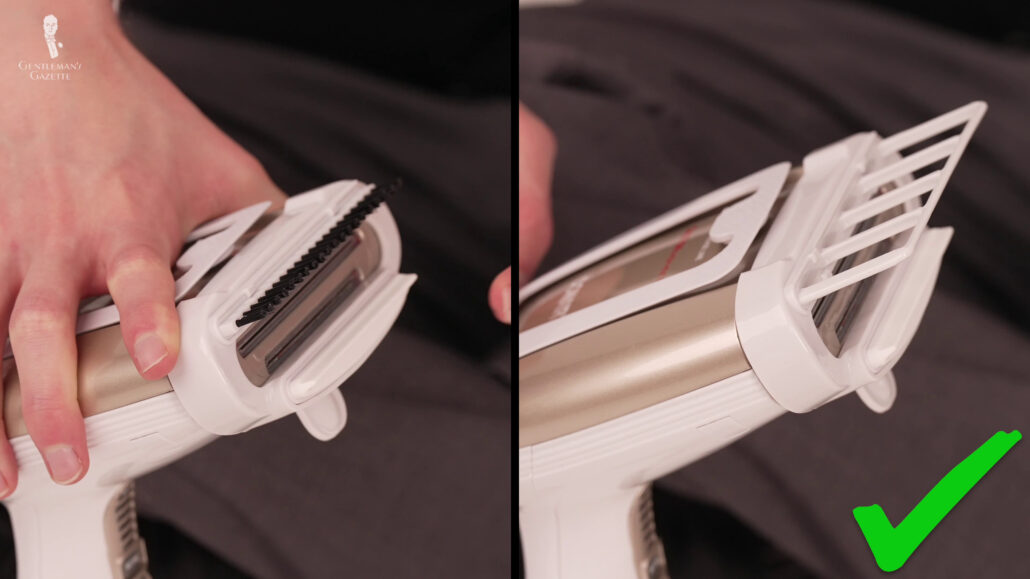
The ConAir features a three-in-one head attachment with a rubber piece on the bottom of the main element that can also incorporate a brush or a spacer so that the steam and the head aren’t directly touching more delicate fabrics.
These go on and come off fairly easily, and they could potentially provide some additional functionality, but we frankly didn’t feel the need to use them since the steamer worked so well just in its normal state.

The PureSteam comes with a fairly standard brush attachment and also a hanger that you can put your clothes on for easier steaming. This might be nice if you didn’t happen to have any other clothes hangers on hand. Though, we found that simply using one of our own hangers allowed the garment to sit more naturally while it was being steamed, and, of course, the on-off switch of this model can be operated with your foot if you choose to do so.
The Jiffy steamer provides a hook in addition to a place to set the wand so that you can use your own hangers while steaming. The metal head gives the unit increased durability and allows for maximum temperature at the source, though, again, keep your thumbs away.


And it’s not really an accessory per se, but the Jiffy steamer does also come with a wrench that you can use to tighten down the hose assembly when you’re putting the unit together. Use this, or you might get some slight leakage at that connection point, as we did before we tightened things down properly.
9. Warranty
Whenever you’re dealing with an electronic device, it can be helpful to have a warranty to fall back on if things go wrong and, of course, it’s also a bonus to have dependable customer service to help you out when necessary. Obviously, you hope that nothing will go wrong with your steamer but, if the manufacturer stands behind their product with a generous warranty, that’s usually a sign of higher quality.

Reading directly from the manual for the HiLife steamer: “We provide the three-year warranty service from the date of purchase for the defects in material and craftsmanship. If this product is found to be defective, please contact us directly to initiate the return and warranty process.” Contact information for customer support is also provided.
I did notice, though, that due to somewhat vague wording in the manual, use of non-distilled water may void the warranty, so this is something to keep in mind.


As for the Atefa steamer, perhaps unsurprisingly, given the build quality or the fact that this may have been a previously returned product, we found absolutely no warranty information in the manual or elsewhere in the box.
ConAir provides a limited one-year warranty for residents of the United States and Canada. We’ll excerpt the first sentence here: “Conair will repair or replace (at our option) your unit free of charge for 12 months from the date of purchase if the appliance is defective in workmanship or materials.” Product registration and customer support details are also provided.
![Puresteams Warranty Disclosure PureSteam's warranty disclosure: "[An] industry-leading 5 year warranty that begins on the date of purchase"](https://www.gentlemansgazette.com/wp-content/uploads/2023/01/PureSteams-warranty-disclosure-1030x579.jpg)
The manual for the PureSteam seems quite proud of its industry-leading, five-year warranty that begins on the date of purchase and also offers product registration and customer support.
In their small novel of an instruction booklet, Jiffy provides a limited three-year warranty, return policy, product registration, and customer service contact information. Some notable excerpts include: “If any part proves to be defective, this product will be repaired free of charge. A nominal handling feed does apply.” Slightly oxymoronic, no?
“Jiffy steamers are built and tested in our factory in Union City, Tennessee.” So, if made-in-America products are a high priority for you, this is something to consider.

And, finally, “Cords are excluded from the warranty.” Good to know.
10. Safety Features
Finally, you want your steamer to have certain basic safety features to ensure safe operation. Reputable companies are required by law to have features that ensure safe operation under normal conditions. These would include things like temperature Inhibitors while water is still in the tank to prevent overheating, but it never hurts to check what the individual models actually have to offer.
While the HiLife steamer doesn’t list any particular safety features for the unit itself in its manual, it does feature over two pages of guidelines for safe operation of the unit. As with the HiLife, the Atefa steamer lists do’s and don’ts for safe operation more so than any features inherent to the unit.

Due to more broken English in the manual, however, some of the instructions – such as “Please use our customized cable. Do not put the cable under thermal environment.” – have gotten a little lost in translation.
Continuing the trend here, the ConAir manual mostly lists do’s and don’ts for safe operation. The instructions here, however, are easy to understand. The same is also true for the PuteSteam, as well as the Jiffy. And in the latter case, the manual for this one makes mention of an automatic overheat shut-off, which is probably a good feature.
Conclusion
So we hope that this post has provided you with a series of guidelines on what makes a good garment steamer and how you can effectively test steamers yourself.
Among the models we tested today, we would rank them as follows:

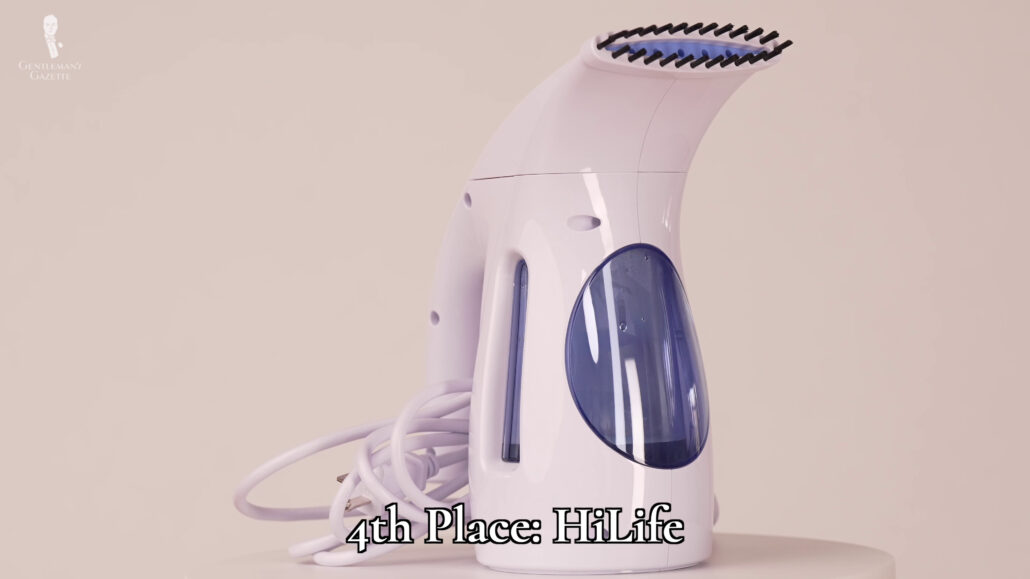
In fifth place is the Atefa, an unpleasant, fiddly, ineffective experience from top to bottom. We’re not even totally sure that we received the genuine article, but we would probably encourage you to stay away regardless.
In fourth place is the HiLife. Usable in a pinch but not terribly effective or efficient. Easy to fill but easy to spill. We would recommend that you use something like this only as a last resort.
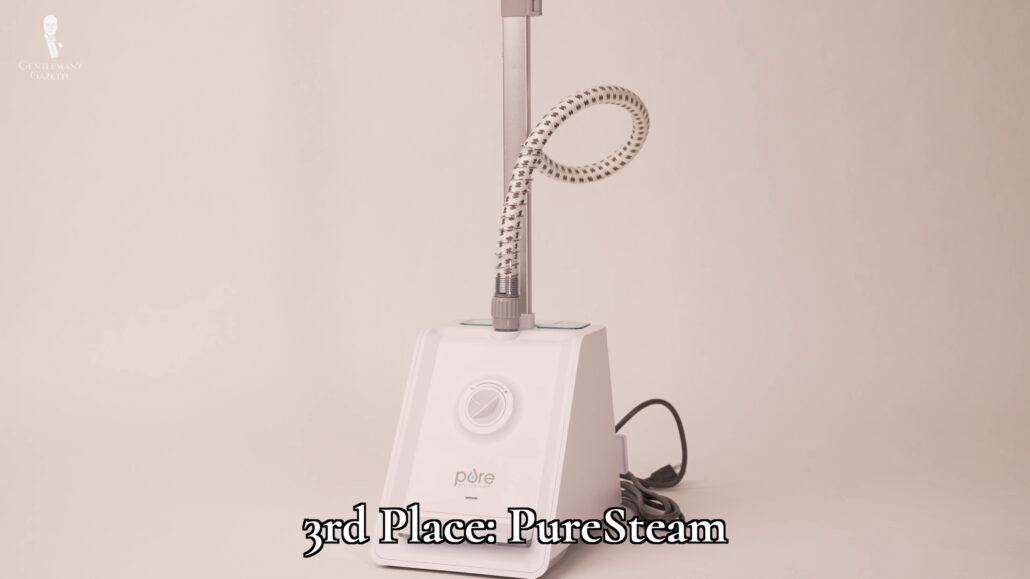
In third place is the PureSteam. The results of wrinkle removal were passable, and the tank capacity is good. Still, it’s not terribly mobile or effective and not really recommended from us overall.

And rather than ranking second and first separately, we’ll simply say that the ConAir and the Jiffy both performed well. If you think a handheld steamer would suit your needs best, consider the ConAir; and if you’d like to go for a full-size steamer, consider the Jiffy; or perhaps, if it makes sense in your budget, you could go with both.

As one more note here, there are, of course, other models out there to try. A few years ago, I picked up a travel-size steamer in the clearance aisle at Aldi for right around $15, and it’s still my go-to steamer today.
A quick Google search shows that a model very similar (or perhaps the same) is available on Amazon under the name “Beautural.”

In any case, we won’t go into more detail here, do consider that it may be worth doing your own testing of garment steamers to see what works best for you.
What garment steamer models do you recommend, and have you had personal experience with any of the ones we tested today? Let us know in the comments below, and we promise not to get steamed if you disagree with any of our assessments.
Outfit Rundown
Today, I’m wearing a casual outfit, good for doing some garment care around the house. The central element is my simple, black cardigan sweater, and I’m wearing it over a fine-striped shirt featuring gray and white. The shirt has French cuffs, but I’m wearing them configured in a barrel style with some simple black links that aren’t meant to be seen under the sweater sleeves.
My trousers are plain charcoal gray to reinforce the color feel, and my black loafers are simple models from Allen Edmonds that feature a comfortable rubber sole.
Also, part of my outfit today is a vintage watch, which is a new addition to my own collection. I purchased the watch from Delray Watch Supply. They’re a frequent collaborator of ours in that they send us watches to film, however, they’re not sponsoring today’s post.
As mentioned, the watch is vintage, and it comes from the American company Benrus. It dates to the early 1960s, and its specific model number is 3081. The case is slim and silver in color, and the face of the watch is also silver. Though, it does have a warm cast to it. I’ve got it on a simple, black leather band for the moment to harmonize with my current outfit, though I may have to buy more bands in the future to allow the watch to go with more other outfits as well.
Also, to go with the color feel, I’m wearing my silver wedding band today, and, to go with the casual nature of the outfit, I’ve left product out of my hair and let my beard grow a bit.
Finally, rounding out today’s outfit are my two-tone shadow striped socks in charcoal gray and light gray from Fort Belvedere. You can find the socks I’m wearing today, as well as a wide array of other classic menswear accessories, by taking a look at the Fort Belvedere shop.


